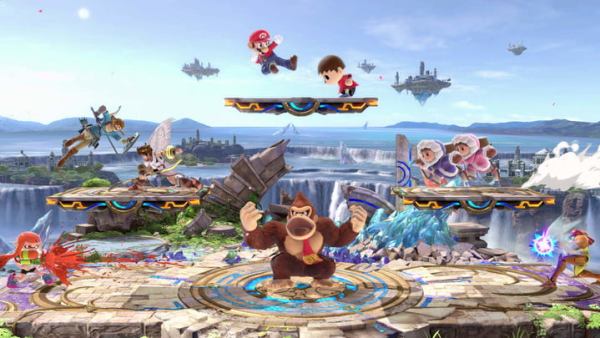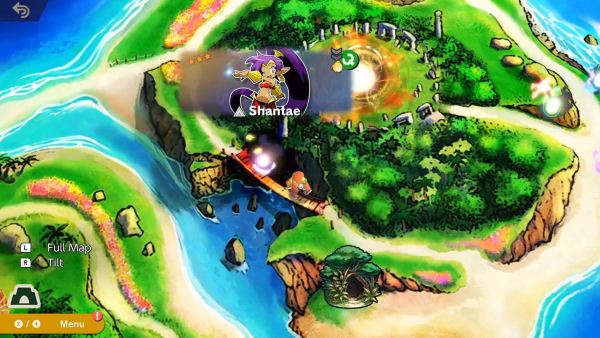Super Smash Bros Ultimate on Nintendo Switch
The legacy of Smash Bros is at the heart of Nintendo’s ability to bring people together over video games. It’s one of those games that you bring to parties, you have friends over to play, you even play with strangers on a little CRT TV in the corner at a convention.
At this point, Smash feels synonymous with the idea of a party game, and Super Smash Bros Ultimate harnesses that legacy into one incredible package.
In terms of sheer breadth and content, it’s one of the most impressive games I’ve ever seen. Ultimate makes a strong case for being the very best Smash game yet, making countless improvements and changes to core gameplay while bringing a host of new ideas and content.
In case you hadn’t heard, Ultimate brings every character that ever appeared in the series back, while introducing a stable of new ones like Incineroar from Pokemon or the Inklings from Splatoon.
It’s a massive roster that consists of 74 characters if you count the Mii Fighters as three separate ones.
Let’s get the most important thing out of the way: the new fighters are a phenomenal addition to the series. Each of the new characters is incredibly unique, from the tools and whip attacks of Simon to the close range wrestling power of Incineroar.
As you might expect from Smash, each of these characters are incredibly well thought out and contain moves representative of their own series.
In particular, the Inkling amazed me at how its moveset feels directly ripped from Splatoon. The character has the ability to ink enemies, which increases the damage they take, and each of its specials are themed around a different weapon from Splatoon.
Even the victory animations are fitting of their series, with a particular favorite of mine having the camera pan out to the side of Simon, and then have him jump up and down and swing his whip just like in 2D Castlevania.
While there aren’t as many, a few new stages are introduced with Smash Bros Ultimate as well, like Moray Towers from Splatoon or Dracula’s Castle from Castlevania. The new stages in the game are some of my favorites honestly, and each one is vibrant with animations and effects.

With 103 stages in the game currently there’s no shortage of arenas to choose from, and while not every stage from the series is present, it definitely feels like a “greatest hits” compilation.
Even the new Echo Fighters surprised me with how much variation they have, like Chrom being Roy’s Echo but having an Aether ability as his up special, or Ken’s entire moveset functioning just a little differently than Ryu’s.
The care and attention to detail taken with each fighter is something that translates to the game as whole. I’ve played Smash since the very beginning on N64, and there were little changes I noticed across the board with so many characters.
Marth’s down special is much easier to execute and each variation of it is now different, Toon Link’s moves have been differentiated from the other Links, Ganandorf now uses a sword for his Smash attacks, the list goes on and on.
These changes also apply to the basic gameplay. Each character has an easier time launching enemies, with multiple attacks that can launch and get a KO.
This doesn’t mean it’s easier, necessarily, just that there are more options for getting KOs now other than doing one strong Smash attack.
My favorite changes involve dodging and the final kill of each match. The animations for dodging have been greatly enhanced, now showing characters moving in very specific animations to avoid attacks, adding to the overall quality.
The final kill of every match also gets a snazzy animation now, with the camera zooming into the actual final hit and time slowing for a few seconds.
That core gameplay is still Smash at its best though, and as a whole things feel fairly balanced. There are certain moves here and there that might need to be altered or toned down, but it seems like Ultimate really strives to make an even playing field for everyone regardless of which character they want to play as.
Now that we’ve talked about all the changes, let’s get to the actual content of the game, which, as I said before, is absolutely massive.
Just the basic Smash option in the menu is packed with options like applying special rules, creating a tourney, a new squad mode that lets you swap out characters, and more.

Classic Mode returns for every character, except Mii fighters, and this is by far the best Classic Mode in the series. Each and every character has a themed Classic Mode, like Marth going up against dragons, Mega Man fighting opponents that represent Robot Masters, Wolf fighting characters reunited from Brawl, Toon Link fighting team battles with other Toon Link helpers, and more.
These Classic Modes are a blast to play just to see how specific each one is, and there are ample rewards at the end as well in the form of Gold to spend in the in-game shop, new Spirits, and items to level up Spirits.
Speaking of Spirits, that’s the biggest addition that comes with Smash Bros Ultimate. Spirits is an entire option from the main menu and it contains the game’s Adventure Mode and the Spirit Board.
Spirits are basically sprites that you can equip on your characters that enhance their stats and add a variety of bonuses or changes. You can equip a Primary Spirit that affects your attack and defense.
On each Primary Spirit you can equip Support Spirits that add a variety of effects, like starting you with a Beam Sword, increasing your shield endurance, or increasing the power of your dash attacks.
These Spirits can then be used in a wide array of Spirit Battles on the board or taken into the Adventure Mode, World of Light. I go into more detail on the Spirits system in another article, but as a whole, I really enjoyed the system.
There’s over 1,000 Spirits in the game and they run the gamut from Nintendo’s most popular and well-known titles to more obscure ones, like The Last Story or Hotel Dusk. There’s also a ton of third-party Spirits from series like Metal Gear and Castlevania.
Spirit Battles are highly imaginative and really strive to represent the character and series they’re from, with things like a horde of yellow Yoshi for a Pikmin fight or four Wario that only use the motorcycle side special for an Excite Truck battle.
With everything we’d seen of World of Light before release, I wasn’t expecting a mode as large and complex as what’s in Smash Bros Ultimate.
In World of Light you advance across a world map taking on tons of different Spirit battles and saving the roster of playable character by “Awakening” them, basically beating them in a battle. However, there are also dungeons to explore, obstacles to clear out, and treasure to find.
The mode is quite long, taking me nearly 30 hours to complete and there are quite a few surprises along the way.
I won’t spoil anything, but some of the dungeons are particularly interesting, often sporting some light puzzle solving, and helping to highlight a point of video game or Nintendo history. There’s also challenging boss battles to fight along the way, like Rathalos or Ganon from Ocarina of Time.
Short cutscenes help highlight the beginning, middle, and end of the mode but otherwise it’s entirely gameplay-based, unlike Brawl’s story mode Subspace Emissary.
The mode does, however, have a fantastic finale with one particular moment that might be my absolute favorite gaming moment of the entire year.
I won’t spoil it, but needless to say it’s a real treat for fans of the Smash series. If the amount and diversity of Spirits is impressive, even more impressive is the phenomenal soundtrack of Smash Bros Ultimate.

There are over 800 songs featured in the game; some original versions, some previous remixes from the series, and some entirely new remixes.
Without a doubt, this is the most extensive collection of video game music that you’re going to find in any game out there.
Third-party series are well represented, with Castlevania in particular sporting a ton of music, with a bunch of new remixes as well.
The only disappointment when it comes to music is that there are only two tracks from Final Fantasy included,which is unfortunate considering the series long and storied history with iconic and recognizable soundtracks.
Smash Bros Ultimate even gives you an in-game music player to use, with the option to turn the screen off in handheld mode while listening to music, in case you want to use it as a music player.
Honestly, I’ve already started using it as a music player for periods of work, and the game consistently rewards you with new music.
Amazingly, Smash Bros Ultimate also runs like a dream in handheld mode, sticking to the same framerate it does in docked with nary a hitch, at least when playing locally.
Using a GameCube controller is still my preferred way to play Smash, but using the Joy-Cons in handheld mode still felt good and intuitive. I don’t know if I’d want to always play Smash handheld, but it works incredibly well for taking it on the go.
Smash games have always been known for their quality, but it feels like Masahiro Sakurai and the development team really went above and beyond with Smash Bros Ultimate.
Every aspect of the game feels fine-tuned and thought out, and the sheer amount of changes and diversity of content is simply staggering.
This is the most ambitious and all-inclusive Super Smash Bros entries, and one of the very best games Nintendo’s little system has gotten yet.
Score: 5/5 – Exemplary
For more information on how we review games, check out Twinfinite’s review policy here.
